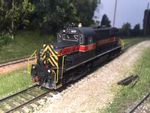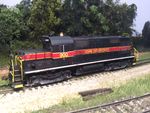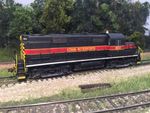|
|

A view of the front pilot and short hood details. The Bowser/Cal-Scale RS-32/RS-36 detail kit ( http://www.bowser-trains.com/history/hocalscaleatlastrainmanrs.html ) was a great help on this model, providing the grab irons, MU and air hoses, and lift rings. The kit also includes other parts that weren't appropriate for my prototype, so I'd encourage anyone building one of these models to check it out as a starting point.
Ditch lights and cut levers on the 900 are Detail Associates parts, #1022 and #2211 respectively. MU stands are modified P2K parts from the scrap box, with the top MU port removed and a Details West #172 step light added in its place, pointed to shine toward the coupler, per the prototype. Pilot steps were removed, gaps were filled, and new pilot plates were fashioned from styrene, with 18” straight grab irons added to contain the MU hoses. Finally, the drop steps were scratchbuilt. I couldn't find an etched material that matched the Alco pattern on those drop steps, so I instead used Scale Scenics #652-3500 aluminum micro mesh with styrene reinforcements.
This view also shows cab roof details. The horn was kitbashed from scrap box parts, the firecracker EOT antenna is Detail Associates #1805, and the Sinclair radio antenna is Details West #274. By: Joe Atkinson
|

Conductor's side view. There are no Smokey Valley handrail sets that are correct for these, so I bent my own. I cut the factory stanchions away, then laid them on my workbench surface and, based on a Neil Schofield tip, used a T-pin to make a pilot hole under magnification and drilled each one out. This process was actually easier than it sounds. Including the time spent to bend the new handrails (using the factory end sections as a guide), it took about two hours total, but in my opinion, the improvement in appearance is well worth it.
The hand brake chain and pulley mechanism was made by drilling holes in the front truck sideframes inboard of each brake cylinder and fashioning pins out of small guage wire, pinning Detail Associates #2210 chain material in place. Pulleys for the rear cylinders were made from parts left over from a Cannon short hood kit, drilled out for the pins.
The dynamic brake vent was opened up by sawing vertically just inside of both end walls, scribing along the bottom to remove the original cast-on vent, and making a new top plate from 0.010” styrene. The vents were added using the Scale Scenics mesh material mentioned previously.
By: Joe Atkinson
|

This view shows the Bowser/Cal-Scale lift rings and other details. The three lift rings on each side, along the outer edge of the roof, are bent from wire, since I felt the kit's parts were too large for that application. The Atlas exhaust stack wasn't right for the 900, so I added added a styrene plate and shortened a stack from a Kaslo M420R. It's still not correct, since the prototype stack is rounded on the ends and flares outward, but I haven't yet found a suitable replacement.
I thought it was neat that Atlas added the "CO B. 7-89" stencil for the paint location and date on the lower rear corner of both sides of the long hood. I believe the 900 is the only IAIS unit to get this treatment. I had seen the stencil on the prototype unit in photos, but could never tell what it said until viewing the Atlas model under magnification. I found it especially interesting in that my layout features the Council Bluffs enginehouse in which the prototype 900 was painted.
The Atlas fuel tank was too wide and had the air cylinders cast in, so I removed them, scratchbuilt new cylinders from styrene and wire, and narrowed the fuel tank. I also removed material from the fuel tank portion of the frame in order to allow the more narrow tank to fit over it. It's still not 100% accurate, but I think it improves the 900's appearance and hope the discrepancies aren't noticeable. I believe the prototype tank is a foot or so more narrow still, but this is as far as I was comfortable taking it without major milling of the frame and potential issues with frame strength and integrity of the pocket holding the motor.
By: Joe Atkinson
|
Rear of the unit received the same treatment as the front. After being used to modeling primarily EMDs, the prototype's grab iron arrangement seems like overkill, but I think it adds a lot of interest to this unit. By: Joe Atkinson
|
IAIS 900 meeting sister Alco 850 at Atlantic. By: Joe Atkinson
|
Rear of the unit received the same treatment as the front. After being used to modeling primarily EMDs, the prototype's grab iron arrangement seems like overkill, but I think it adds a lot of interest to this unit.
IAIS 900 meeting sister Alco 850 at Atlantic.
|

 All images on this site are copyrighted by their respective creators, and used with permission.
All images on this site are copyrighted by their respective creators, and used with permission.